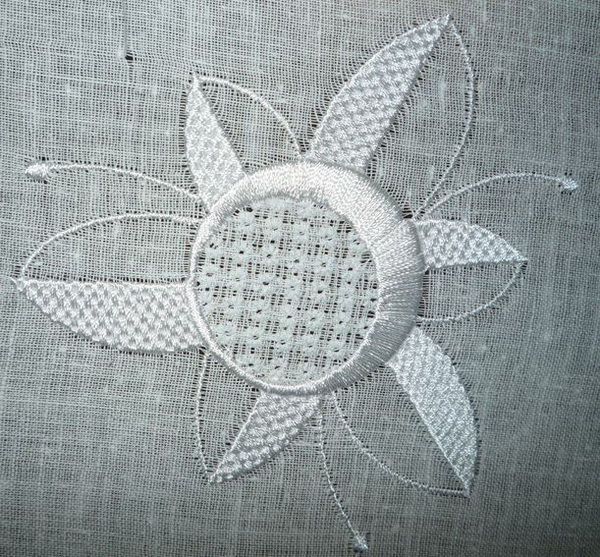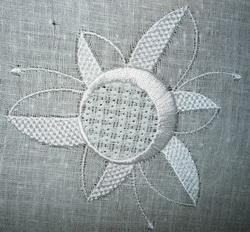Original text by Marina Belova
Pulled thread embroidery (also called Dresden work) is one of the most popular kinds of openwork. You create the openwork by pulling the fibers of the fabric in a certain order. You will get a netting with small holes as the result. The motif stitches form the basis for the netting. It is better to embroider on the fabrics with easily separated fibers (loosely spun linen, batiste, muslin, organdy etc. Even calico will be good).
It is said that this method can be used for almost any elements: flowers, leaves, wings of the insects, various enclosed areas. I think that this technique can mainly be used for decorating napkins, blouses, creating lace edgings and so on.
Of course, not all types of motif stitches are suitable for Dresden wrk. The main principle of creating the netting should be based on the following rules: in order for the fabric to gather, it is necessary that the stitches that form the design are repeated at least twice. These may be classic squares, diamonds, zigzags, stars etc. This repetition will allow for the fibers to gather even more, and a hole will appear where the needle pierced the fabric. I think that the suitable motif stitch can be found without effort in any embroidery editor. Or I will have to create the motif stitching myself. The only trouble is to find the motif of a suitable size that will gather the fabric. But this is what the test runs are for.
In commercial machine embroidery, the needles used for pulled thread embroidery are often thicker than necessary for the particular type of thread (I've heard the recommendations to use #100-120 needles with the ordinary type threads). In is necessary for the visible holes to appear in the fabric. The only thing that is not clear is how the thick thread will work with the needle thicker than needed. As usual, you won't know until you try.
As for the sewing and embroidery machines, it is better to use special winged needles that have flanges on both sides, which allow to substantially widen the holes.
I've read many times that you don't need a stabilizer for that kind of embroidery because the fabrics are mostly transparent. But I still have my reservations about this. After all, there may be ordinary kind of embroidery besides the puled thread work, and this embroidery will add to the pull. It is then possible that the stabilizer should be placed under the hoop after the pulled thread embroidery is completed.
I've more than once seen the recommendations to starch the fabric before embroidery. Perhaps, it is needed to make the holes more visible.
Obviously, the thread tension needs proper adjustment, too. In my opinion, if you make it tighter, the pull will be greater, and you will get slightly wider holes as the result. Which is our goal.
Thread thickness and quality do not matter if I understand correctly. I'll just have to find the suitable ones by trial and error.
In theory, everything seems very simple (as it usually does).
Here is the result of my attempts to create something resembling the pulled thread embroidery in the flower cup:

For the flower cup, I picked a #80 needle and #30 thread. I used the standard polyester thread for the rest. I didn't use the starch because my fabric is dry and coarse enough. Both and warp and weft threads are easily separated. Which you can easily see in the photo.
Well... I have to practice again and again — not very satisfactory holes indeed. I am falling under the impression that the ordinary flat embroidery causes holes much bigger in size. Though I tried to create a motif stitching in which every stitch would be repeated twice, as suggested. Perhaps, 2 runs are not enough. I'll go and mull it over. I think that I should consider adding more color to the netting.
P.S. You can read the next chapter here.
Edited by Irina



There are no reviews to display.